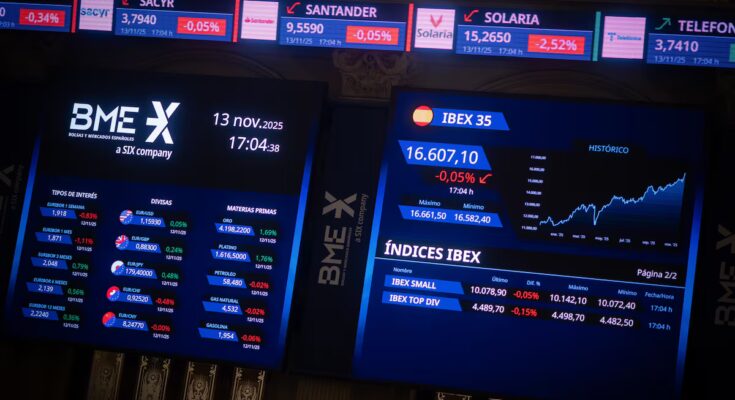American investors’ doubts about the technology sector are starting to infect the Spanish market. European stock markets accelerated their declines and the Ibex fell by 2%. The punishment of Oracle or Nvidia is triggering a flight from risk that moves to other assets, such as cryptocurrencies, and is reflected in debt, where a moderation in US bond yields is seen. This market distrust, which is expressed most crudely in the assets that have recorded the biggest gains this year, coincides with the end of the US federal government’s lockdown, which will give rise to a glut of figures that could show a weak economy or cool the outlook on interest rates. The market, which two weeks ago was assuming a Federal Reserve cut in December, now calculates only a 50% probability.
Although the weekly market balance is positive for all the main indices, with the exception of the American Nasdaq whose losses are limited, volatility has taken hold in the market, with technology at the center of attention. Nvidia, the world’s largest publicly traded company, fell 7% between Tuesday and Thursday, but posted strong gains on Monday. Nerves in the markets are tense after weeks in which calls for caution regarding a possible technology bubble have multiplied. “Markets seem to be very spooked by fears of an AI bubble,” Vishnu Varathan, head of macro analysis at Mizuho, told Bloomberg. “Technology, which generally tends to be more sensitive to Fed easing.”
The declines also worsened in the rest of the European stock markets, with the Euro Stoxx 50 losing 1.8%, the French Cac 1.7% and the German Dax 1.7%. US futures point to further declines, with drops of 1% for the S&P 500 and close to 1.5% for the Nasdaq. In Asia, Japan’s Nikkei fell 1.7% on interest rate concerns.
European technology companies led the cuts, with Infineon losing 5.4% and SAP losing 4.6%. This instability is also evident in the Ibex 35, where only Telefónica and Naturgy show limited gains. Investors penalize, on the contrary, renewable energy companies (Acciona and Acciona Energía lose 11% and 8.7% respectively; Solaria 2%), real estate companies (Colonial collapses by more than 6% and Merlin 6% after the publication of the accounts) and, in general, the entire market, with banks falling between 3.7% for Sabadell and 2.3% for Bankinter.
Another negative aspect is the rise in oil prices, up to 3% in the worst moments of the session, after Ukraine’s attack on the Russian terminal in the Black Sea, fundamental for crude oil exports (even if the country is subject to international sanctions). An increase that moderated to 1% mid-session.
In the debt market, despite lower prospects of Fed rate cuts, risk aversion is pushing down US debt yields. The ten-year bond yield declines to 4.07% and the two-year bond yield moderates to 3.55%. The dollar appreciates slightly against the euro, although remaining at 1.16 units for each currency. And the greater perception of risk modestly widens European risk premiums, with the Italian title rising by four points against the German’s two or the Spanish’s three.
Stock Markets – Currencies – Debt – Interest Rates – Commodities



